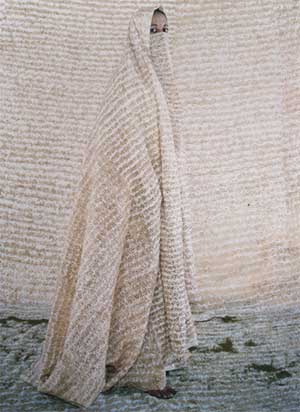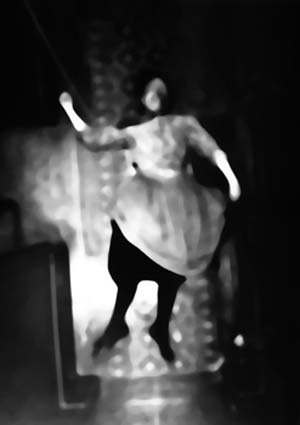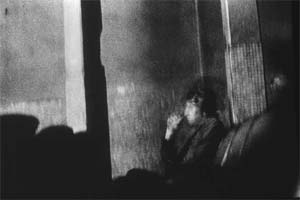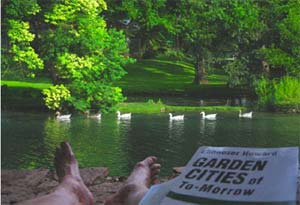With more than 120 exhibitions of photographic work displayed around Houston for the 11th annual FotoFest, how is one to choose what to see? The shows reviewed here are related geographically more than thematically, and in fact, are quite disparate in terms of how they use the photographic medium to convey their messages.
Lalla Essaydi at Anya Tish Gallery uses the camera to document gatherings of Islamic women, while Maria Martinez-Cañas did not use a camera at all to produce her work at De Santos Gallery. Miguel Ángel Rojas at Sicardi Gallery uses photographs to make socio-political statements relating to his life in Colombia. Houston renaissance man David Crossley began his professional life as a photographer, but is presenting his vision of a future for a city that tends to value strip centers over green spaces at Joan Wich Gallery. All the exhibitions address, in some way, the twin themes of FotoFest – Artists Responding to Violence and The Earth.
Lalla Essaydi: Converging Territories at Anya Tish Gallery
“I am writing. I am writing on me. I am writing on her.” Thus begins Essaydi’s journal, the words of which are transcribed in henna upon every surface in her color photographs – women and children’s faces, hands, and feet; eggs at their feet; fabric draping the walls and floors; and veils wrapping their bodies and covering, in most cases, all but their eyes. The women are unmistakably Islamic, and the Arabic words are written in the beautiful art of calligraphy. Right away, it is apparent that the use of calligraphy, one of the most revered of all the Islamic arts, traditionally practiced only by men, has been manipulated. She describes the photographs as a subversive engagement that conveys her own experience as an Arab woman caught somewhere between past and present, East and West.
Essaydi was born into a prominent and conservative Muslim family in Marrakech. If she disobeyed in any way, she was exiled to her grandparents” deserted 500-year-old palace with only servants for company. When her brothers took her to a nightclub to celebrate her 15th birthday, she was sent to the palace for a month to contemplate her transgressions, while her brothers were not punished in any way.
Essaydi returned recently to the place of her exile, which she calls a psychological space. She invited female family members and friends to join her for a “workshop” in which the women covered the walls, floors, veils, and their bodies with words written with henna in the forbidden script. The use of henna is a crucial component to the work, as it is associated with a Moroccan woman’s passage to womanhood, marriage, and the birth of her children. These photographs were taken in the largest room of the house, once reserved only for men, but Essaydi has removed all references to place, leaving the text to become the subject of the work.
At the age of 16, Essaydi married an older man from Saudi Arabia and moved there to live and have children. Later, she spent summers in Paris studying art and painting, and her first trip to the U.S. was just a decade ago. Since then, Essaydi has shown her work around the world, including the 2004 FotoFest. The title of the current show, Converging Territories, suggests how the photographs reflect her ongoing investigation into the past in order to understand how it affects the present. She questions the nature of authority and the submission of women to men, along with the power of words and images to effect changes in society
Lies by Maria Martinez-Cañas; Dustograms by Martinez-Cañas and Kim Brown, curated by Ricardo Viera at De Santos Gallery
Upon entering De Santos Gallery, you are confronted with 12 soft-focus black-and-white photographs. The titles, all of which begin with the word “lies,” are purposefully misleading as far as the actual sources of the images. Lies: Doll and Lies: Michelin Man resemble their titles literally, while Lies: Cityscape 3 and Lies: 47 do not. Cityscape 3 appears to be a bedroom, while 47 looks like a wall of books or file boxes. Martinez-Cañas makes her point. As it turns out, these images began their life as snapshots from a crime scene, which have been manipulated and transformed. Martinez-Cañas explains somewhat enigmatically that a terrible personal experience made her confront how easily people tell lies, and through her work to call into question the popular notion of photography as “truth.”
Martinez-Cañas has never been interested in ‘straight” photography. For this show, she did not use a camera at all, but appropriated the images from the public domain and reworked them over and over again in a laborious process that can take up to year. Her unconventional approach results in ephemeral photographs with a very painterly quality. Martinez-Cañas” work has always been very personal, very much about her history and her feelings of displacement from her home country of Cuba.
Upstairs is Dustograms, a collection of collaborative works produced by Martinez-Cañas and Seattle-based conceptual artist Kim Brown. The two met in Germany, where they were each working separately. After a tentative beginning, they decided to collaborate on these pieces, which will also be shown later this year at the Lehigh University Art Gallery in Pennsylvania.
Brown has been working with dust for some time, collecting it and in this case stitching it into surprisingly lovely objects, or sewing it in circular patterns onto rectangles of gauze. Multiple mound-shaped sculptures and pattern pieces are displayed along with the photographs (which are actually photograms). Brown then sews more dust onto the actual surfaces of the images, creating sculptural photographic objects that are displayed in clear shallow boxes.
If Lies is about Violence, Dustograms is about Earth. As Brown explains in her statement, “Dust comes from everywhere and nowhere and goes everywhere and nowhere; dust is the fragile and ephemeral evidence of the presence of life.”
Miguel Ángel Rojas at Sicardi Gallery
Colombia artist Miguel Ángel Rojas began drawing at an early age, but was not permitted to study art until he tried architecture and English. His show at Sicardi Gallery includes photographs, drawings and video. The photographs are dark, shadowy images of figures seated in what appear to be empty theaters. Most of the images are reworked snapshots taken furtively in 1979 in Bogotá, at gay movie theaters where men would go in search of anonymous sexual encounters.
Early on, Rojas became engaged with the idea of drawing on his life experiences for subject matter. In 1973, he shot peephole Polaroids of urinals in a men’s room, and began experimenting with them. Between 1975 and 1979, he took pictures with a hidden camera in the Faenza movie theater and in the toilets of another theater in Bogotá. He reworked the negatives, grouping them into series and sometimes adding text. For Rojas, photography has always been a means to producing a creative image rather than an end in itself.
These photographs suggest rather than illustrate the potential for violence inherent in casual homosexual encounters. Rojas was assaulted in one of the movie theaters when someone hit him in the face. He was wearing glasses, which shattered and cut his cornea, causing him to lose most of the vision in his left eye. In fact, the video in the exhibition is titled Corté en el Ojo (literally, “cut in the eye”). To create it, he returned to the theater recently and shot video, then intercut it with the images from the seventies.
The mixed-media drawings in the show also address violence, specifically that of the Colombia-U.S. drug trade. One two-part piece is composed of small circles punched from coca leaves and dollar bills, in a commentary on the causes of, and social problems created by, this dangerous and highly lucrative business.
Rojas’s photographs are clandestine, voyeuristic images are both ominous and seductive. He moves easily between photography, collage, video, assemblage and appropriation, using whatever medium is most appropriate for conveying his socio-political messages.
Houston: Green City, Garden City, curated by David Crossley at Joan Wich Gallery
Although this show includes images by seven photographers, it is less a show about photography than an exploration of how to make Houston a more livable city through “green” intervention strategies.
Presented under the aegis of the Gulf Coast Institute, the show uses dozens of large-format color photographs to illustrate Houston’s existing green spaces in a dazzling floor-to-ceiling display. It also uses large format prints to illustrate how other cities have used urban planning to preserve their green spaces. A third component of maps forecasts Houston population growth, making reasonable guesses as to where people will be living and working in 2035. Finally, a group of graduate students from the Gerald D. Hines College of Architecture at University of Houston have created computer models in which they transformed certain areas of Houston into a new and unique “garden cities.”
The Gulf Coast Institute was founded by Crossly as a kind of think tank to improve environmental quality of life in Houston. In this show, he analyzes the next few decades” projected growth, which if not managed in some way threatens to build over massive amounts of remaining green space. The solution, according to Crossley, is to move toward the more efficient village-like development patterns that have worked in other cities around the world. The wall of 40 color photographs displays rich images of trees, plants, flowers, garden, and insects. It reinforces the message of the other materials, as does a weekly farmers” market in the gallery on Saturdays from 1-3 pm, ongoing through the run of the show. Handouts are also available on other nonprofit organizations such as The Parks People, Texas Coastal Management Program, Sea Grant Texas and Texas Nemo.
I have attended and written about FotoFest since the first biennial event in 1986. As it continues to grow, the sheer number of exhibitions becomes more and more overwhelming. Consequently, I have adopted a more relaxed attitude toward how much I can actually see over the course of one month. The four shows reviewed here present provocative photographers with intriguing ideas that will resonate with you long after you leave the galleries. They can all be seen in an afternoon that will leave you visually and intellectually stimulated and, in my case, ready to see more.
Images courtesy Anya Tish, DeSantos, Sicardi and Joan Wich Galleries
Donna Tennant is a writer living in Houston.







